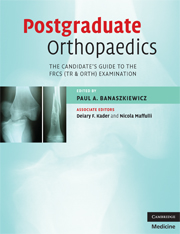Book contents
- Frontmatter
- Contents
- List of contributors
- Foreword by Mr Peter Gibson
- Preface
- Glossary
- Section 1 The FRCS (Tr & Orth) examination
- Section 2 The written paper
- Section 3 The clininicals
- Section 4 Adult elective orthopaedics oral
- 14 General oral guidance
- 15 Shoulder and elbow oral core topics
- 16 Hip oral core topics
- 17 Knee oral core topics
- 18 Foot and ankle oral core topics
- 19 Spine oral core topics
- Section 5 The hand oral
- Section 6 The paediatric oral
- Section 7 The trauma oral
- Section 8 The basic science oral
- Section 9 Miscellaneous topics
- Index
- References
17 - Knee oral core topics
from Section 4 - Adult elective orthopaedics oral
Published online by Cambridge University Press: 22 August 2009
- Frontmatter
- Contents
- List of contributors
- Foreword by Mr Peter Gibson
- Preface
- Glossary
- Section 1 The FRCS (Tr & Orth) examination
- Section 2 The written paper
- Section 3 The clininicals
- Section 4 Adult elective orthopaedics oral
- 14 General oral guidance
- 15 Shoulder and elbow oral core topics
- 16 Hip oral core topics
- 17 Knee oral core topics
- 18 Foot and ankle oral core topics
- 19 Spine oral core topics
- Section 5 The hand oral
- Section 6 The paediatric oral
- Section 7 The trauma oral
- Section 8 The basic science oral
- Section 9 Miscellaneous topics
- Index
- References
Summary
Knee arthroplasty
Aims of TKA
The primary aim of arthroplasty is to achieve:
Weight-bearing line through knee centre
Joint line perpendicular to the weight-bearing line
Soft-tissue balance
Restoring normal Q angle and joint alignment
Anatomic and mechanical axes
The valgus cut angle is the angle between the femoral anatomical and mechanical axes. The normal anatomical axis or tibiofemoral angle measures 5°–6° of valgus.
The mechanical axis, or weight-bearing line, is the line from the centre of the hip to the centre of the tibiotalar joint; it typically measures 1.2° of varus. Hence, 60% of weight goes through the medial compartment.
Femoral roll-back
Femoral roll-back is the posterior shift in the femoral–tibial contact point in the sagittal plane as the knee flexes.
Aetiology of arthritis
Idiopathic
Post-traumatic
Avascular necrosis
Inflammatory arthritis
Contraindications to TKA
Infection
Neurogenic genu recurvatum
Deficient quadriceps mechanism (polio)
Constraint ladder within knee implant design
PCL-retaining (cruciate-retaining, or CR)
PCL-substituting (posterior-stabilized, or PS)
Unlinked constrained condylar implant (varus-valgus constrained, or VVC) provides anteroposterior and varus-valgus stability (substitute for deficient collaterals), e.g. CCK, TC3
Linked, constrained condylar implant (rotating-hinge knee, RHK). Rarely indicated. Used for global instability (total collateral disruption/recurvatum) and severe distal femoral bone loss, osteolysis/fracture
Posterior cruciate ligament (Leo Whiteside)
A major stabilizing ligament in the normal and pathological knee
It tightens the flexion space only
It is a secondary mediolateral stabilizer in flexion
The only mediolateral stabilizer after releasing collateral ligaments
PCL function cannot be corrected by polyethylene post
- Type
- Chapter
- Information
- Postgraduate OrthopaedicsThe Candidate's Guide to the FRCS (TR & Orth) Examination, pp. 194 - 214Publisher: Cambridge University PressPrint publication year: 2008

